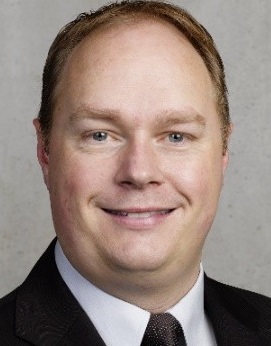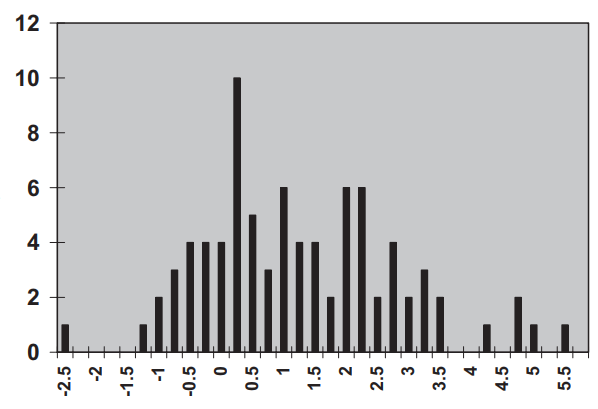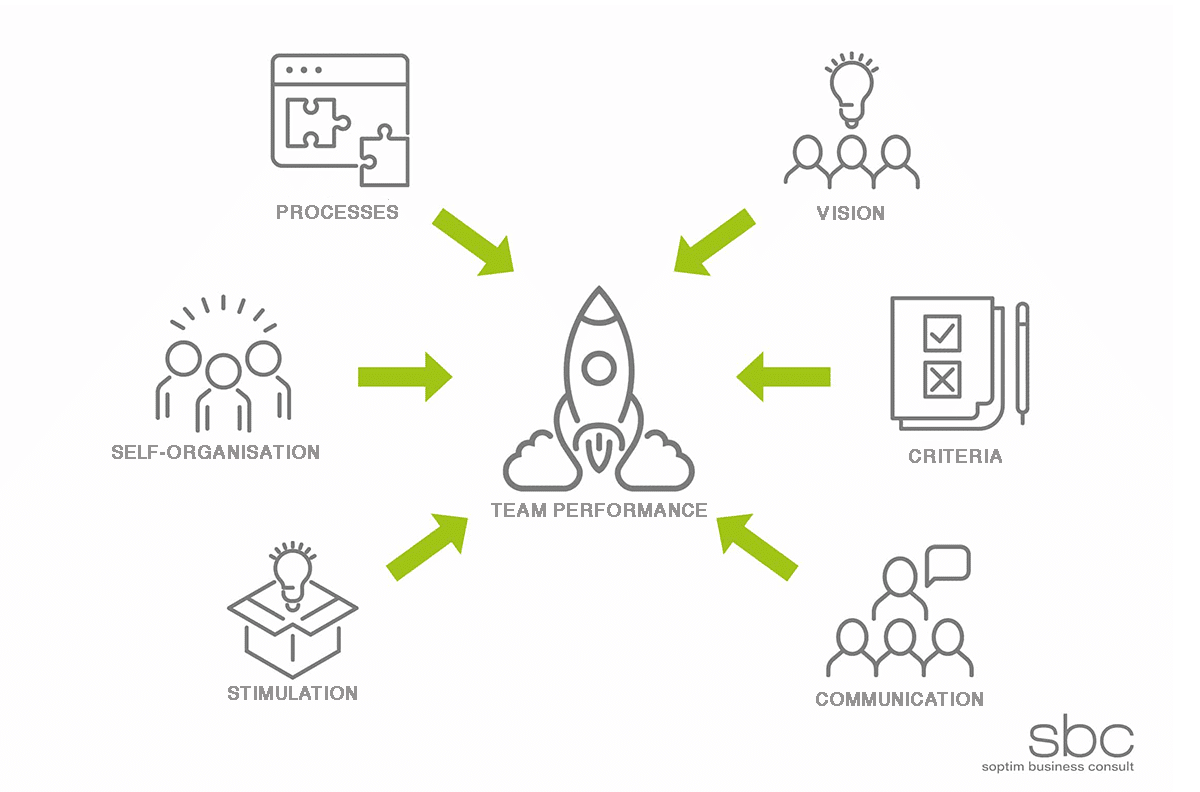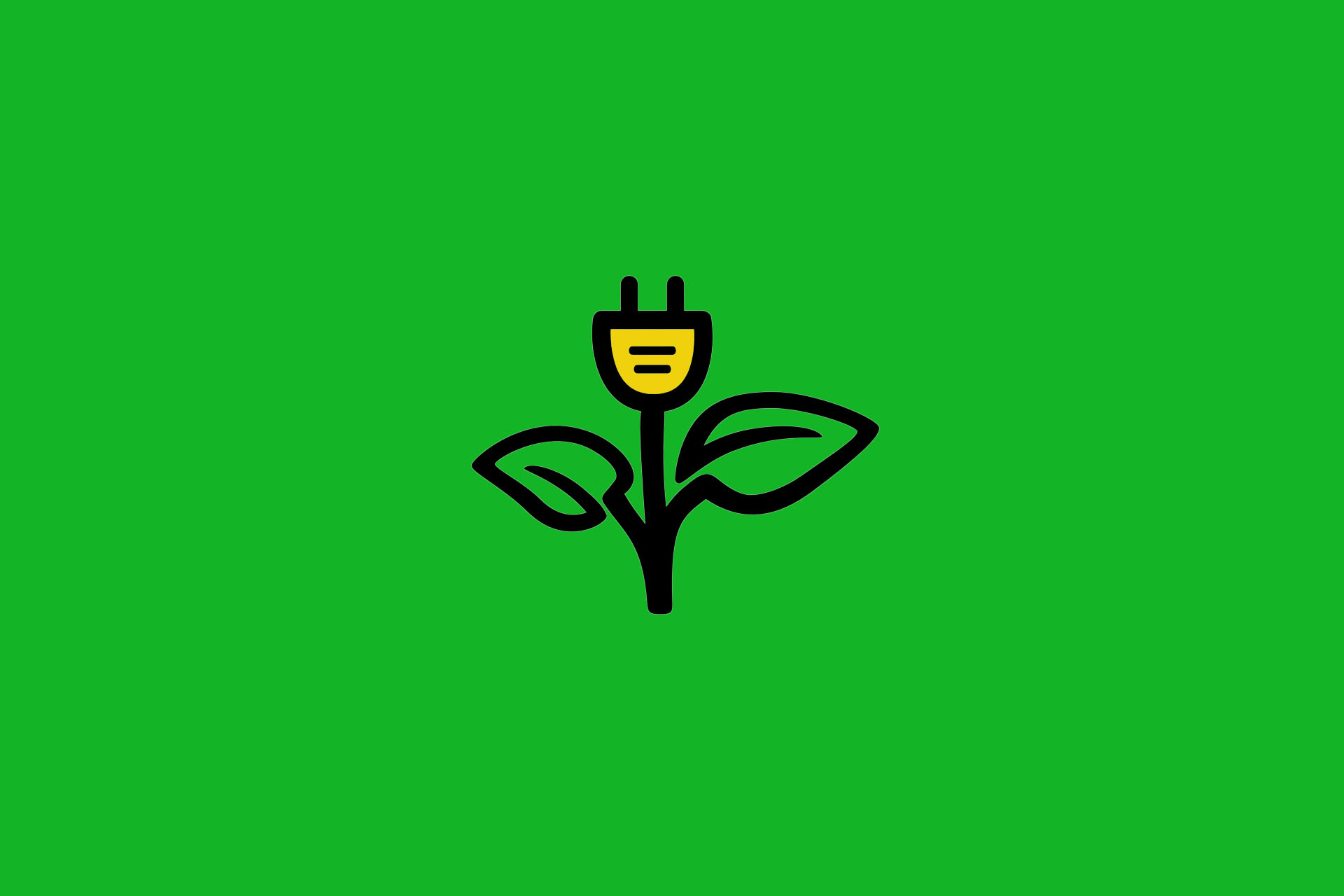Productivity and humanity – contrast or win-win?
Table of Contents
Productivity and humanity – are they not opposites?
Productivity as a natural goal of successful companies
Theory and practice in 2021 – serisously!?!
Self-organisation as the way to more humanity in organisations
Self-organisation as a path to supersummative results
Productivity and humanity as a desirable solution for all
Short und sweet
Is it time for an organisational turnaround? Are productivity and humanity opposite poles? Why do we not rely on robust, scientific findings for many important questions?
These issues have been on the minds of many people in recent weeks, months or years. Obviously, we find it difficult to bring the issue of “theory and practice” but also a core aspect of business – the pursuit of productivity – into really good application. But let’s start at the beginning.
Productivity and humanity – are they not opposites?
Productivity and humanity are not mutually exclusive. If we leave the world and human view of pure (non-thinking) production power, then they are even interrelated. This is true not only within a company, but in strong connection with our economic and social environment (cf. Becker & Langosch, 2002). But also the view of the individual and the group show why productivity and performance orientation are an essential factor, because the “change of values, attitudes in society” have an effect (Becker & Langosch, 2002, p. 148 cont.).
In a world with more change, complexity and dynamics created by more networking, the company must also work together as a collective intelligence. Leaders who still see themselves as a key resource today limit the performance of their organisation to their own (cf. Kruse, 2020).
This is not only no longer in keeping with the times, but in a very complex world it is the basis for the failure of the company. This is where purposeful corporate development, not in the sense of a department, but of constant further development, must come into play. “Successful corporate development leads consistently from individual to team intelligence to the design of self-organised networks” (Kruse, 2020, p. 95).
In this world, the networking of people must be allowed, through communication, leeway and the conscious, purposeful removal of artificial barriers, impediments or outdated rules (DeMarco, 2001; Kruse, 2020; cf. Becker & Langosch, 2002).
Productivity as a natural goal of successful companies
Let’s start with productivity. Every company should have as an objective the continuous increase, promotion or development of its own productivity. Productivity is defined as the relationship between the degree of goal achievement (output) and the use of resources (input). A distinction is often made between labour productivity and capital productivity. We want to focus on labour productivity.
There are now, for example, numerous studies and also some meta-analyses on participative productivity management (PPM) according to Robert D. Pritchard (Holling, Lammers & Pritchard, 1999; Pritchard et al., 2008; Sodenkamp, 2002). This is based on the pillars of goal setting (comparable to task orientation), feedback and participation (Sodenkamp, 2002, p. 19ff.; cf. Pritchard et al., 2008) – up to self-organisation. A combination that apparently does not seem so desirable in the ears of many responsible persons, although the results speak for themselves.
Yet there are both articles that confirm very positive aspects from the combination of different systems with PPM (e.g. Bentlage, 2015). Here, “the presumed synergy effects between the two management systems PPM and Six Sigma could be confirmed” (Bentlage, 2015, p. 332). Likewise, however, comparative research was also able to show that PPM is superior to other approaches such as the Balanced Score Card (Sodenkamp, Schmidt & Kleinbeck, 2002).
The meta-analysis of 83 field studies from numerous countries (e.g. Germany, the Netherlands or the USA) shows very positive effects of the approach on average. A key measure is the effect size based on the d-statistic approach, which ranges from -2.53 to 5.37 with a mean effect size of 1.16 (Pritchard et al., 2008, p. 555). The overall distribution can be seen in the following graph.
Fig. 1: Number and respective effect sizes from 83 field studies on PPM (Pritchard et al., 2008, p. 555).
Thus, the meta-analysis summarises that the “most important finding of this research is that the improvement in productivity was very large” (Pritchard et al, 2008, p. 563; own translation). In numbers, this means that the mean effect size in the feedback phase is 1.16 standard deviations higher than in the introduction phase (baseline; Pritchard et al., 2008, p. 555). Overall, the results are shifted in the positive direction.
Doesn’t this sound like paradisiacal results that should make every managing director, board member or executive look forward to the future? Nevertheless, PPM in Germany and ProMES have hardly been able to establish themselves in international comparisons. Is this due to the frequently cited discrepancy between “theory and practice”? Or do we really find it so difficult to develop people together with the system (Eissfeldt, 2020; cf. Becker & Langosch, 2002)?
Theory and practice in 2021 – seriously!?!
Let’s start with the first topic. How often have you heard that in daily practice? It’s too theoretical or it may be correct in theory, but it’s no good in practice. Kant (1793) already addressed this topic. There is also the saying that there is nothing more practical than a good theory. This is usually attributed to Kurt Lewin.
But what does that actually mean? Can one go through life without any theory, reflections or own insights? Hardly. It means I either rely on scientifically, empirically derived or developed and scientifically verified theories or I accept what has formed in my own head in the daily experience of practice. Anyone who has ever been completely wrong or experienced the Barnum effect¹ in everyday life knows the problems of the latter option. A problem that we are currently experiencing almost daily in politics and the current rules.
Every assumption about the environment, one’s own company or productivity can therefore either represent the complete picture – with all contents, facets and rules – or must inevitably be a reduction. This is then a more or less good, accurate, reliable theory or, accordingly, a model of reality.
Self-organisation as the way to more humanity in organisations
The human image for our employees, colleagues or whatever you want to call them could mark our entry into the right path. The answer to a world that is presumably becoming more complex, uncertain or faster, often referred to as the “VUCA buzzword” (Schenkel, 2019), can only be the smarter organisation. This becomes smarter if I give people space for development or empowerment (e.g. Puckett, 2021), enable self-organisation or self-management or follow the new path of plural leadership (Endres & Weibler, 2019). This also requires different “leaders”.
In the context of the numerous agile developments of recent years with Kanban, Scrum or the management approach Objectives & Key-Results (OKR), this development has gained momentum. And there is ample evidence that it works, if you get involved and put the theory into practice appropriately and correctly.
Logically, it has an effect on humanity, but it can and does have much more far-reaching effects. Earlier studies, not only the work of Pritchard (see above) could show numerous positive developments in various measures of success through
- team communication,
- task orientation or
- psychological safety.
People are good when they are allowed to be people!
Self-organisation as a path to supersummative results
Research on team or group performance shows that supersummative results, when the sum suddenly adds up to more than the simple addition of the individual parts, are possible. This is exactly where PPM comes in. Through the team factors
- feedback,
- task orientation/goal setting,
- participation/self-organisation,
- safety,
- exchange of information and
- group reflection
suddenly many supportive factors come together that we also know from other successful approaches. Here OKR the team climate for innovations (e.g. Rülicke, 2020) or the approaches to group performance should be mentioned.
Ultimately, for some years now (cf. Becker & Langosch, 2002; Kruse, 2020) we have been talking about a significant increase in complexity, more dynamics and thus faster and more complex change. “If the density of networking in a system is increased, then the number of feedback effects also increases automatically” (Kruse, 2020, p. 37). This leads to the effects just mentioned and is at the same time the central solution approach to counteract this.
Suitable, adaptive and learning methods can therefore be the solution to this, if we develop them in a self-organised and stimulating way. Only such a high form of self-organisation with disturbance, stimulation, resonance and phase transitions is agile in the true sense and capable of continuous survival. For this to happen, the next stage must be to turn self-organisation into a new form of organisational intelligence that will be able to grow with it (cf. Kruse, 2020, p. 54ff.). This takes us beyond the previous approaches to organisational learning and the organisational turnaround could be the start of the intelligent, living organisation.
Productivity and humanity as a desirable solution for all
The results of project success, employee satisfaction or even productivity are not an end in themselves or intended to serve a purely feel-good atmosphere for employees. No, it is a win-win situation from which both sides will benefit equally. This is the path of organisational change that many companies still have ahead of them. The research results from hundreds of scientifically evaluated projects prove this.
We need to position ourselves for new worlds and achieve team performance and organisational intelligence. This works through processes and methods (e.g. OKR or PPM), vision and task orientation, clear measurement criteria, communication and feedback, out-of-the-box thinking as well as self-organisation and networking.
Fig. 2: Team performance and organisational intelligence is made up of many factors.
We need to grow our organisations out of today’s rigid organisational form and focus on organisational intelligence. This is based on the approaches already described and must establish itself adaptively – also through collective intuition. Everything is available, researched and described. All that is left now is for those responsible to want it.
Short and sweet
Not only since Wikipedia or Google do we have access to the wisdom of mankind. The information is in front of us, we “only” need to read it, understand it and put it into practice. The central findings of this article are briefly summarised here once again:
- Productivity can be significantly improved, participative productivity management offers everything and has as its (only?) disadvantage the bulky name.
- Productivity and humanity are not a contradiction, but a win-win.
- Theory and practice are not opposites either. If the theory fits the practical problem and is applied correctly, it helps to find a structured solution.
- Self-organisation, agile working and similar developments help to get more out of the system and also to encourage and support the employees.
- This is not an end in itself, but a necessity. Only through networking, mutual stimulation and resilient assessment can organisations still (re)act appropriately to the more complex and dynamic world.
- They can engage in the organisational turnaround if they want to. A more human organisation with significantly higher productivity is waiting for you! Why don’t you go and see it?
Notes:
If you are looking for support in building productivity and humanity, feel free to drop by Soptim Business Consult.
[1] Barnum effect
Sources:
- Becker, H. & Langosch, I. (2002). Produktivität und Menschlichkeit – Organisationsentwicklung und ihre Anwendung in der Praxis. Stuttgart: Lucius und Lucius.
- Bentlage, J. (2015). Arbeitsorganisation – Von der Strategie zur Handlung. Konzeption und Evaluation einer Verknüpfung der Methoden PPM und Six Sigma anhand einer Fallstudie. Dissertation an der Technischen Universität Dortmund: https://eldorado.tu-dortmund.de/handle/2003/34122 [retrieved on: 21.04.2021].
- DeMarco, T. (2001). Spielräume. Projektmanagement jenseits von Burn-out, Stress und Effizienzwahn. München Carl Hanser Verlag.
- Eissfeldt, K. (2020). Working on the system? On people? Both! [retrieved on: 18.04.2021].
- Endres, S. & Weibler, J. (2019). Plural Leadership. Eine zukunftsweisende Alternative zur One-Man-Show. Wiesbaden: Springer Fachmedien GmbH.
- Holling, H., Lammers, F. & Pritchard, R.D. (1999). Effektivität durch Partizipatives Produktivitätsmanagement. Göttingen: Hogrefe Verlag.
- Kant, I. (1793). Ueber den Gemeinspruch: Das man in der Theorie richtig sein, taugt aber nicht für die Praxis. [retrieved on: 20.04.2021]
- Kruse, P. (2020). next practice – erfolgreiches Management von Instabilität. Veränderung durch Vernetzung (9. Aufl.). Offenbach: GABAL Verlag.
- Pritchard, R.D., Harrell, M.M., DiazGranados, D. & Guzman, M.J. (2008). The Productivity Measurement and Enhancement System: A Meta-Analysis. In Journal of Applied Psychology, Vol. 93, No. 3, 540-567. [retrieved on: 20.04.2021].
- Puckett, S. (2021). Empowerment and self-organisation – good preparation is everything [retrieved on: 18.04.2021].
- Schenkel, M. (2019). VUCA, so what?! [retrieved on: 20.04.2021].
- Sodenkamp, D. (2002). Förderung von komplexen Leistungen durch Ziele und Rückmeldung. Die Einführung des Managementsystems PPM in einemmittelständischen Betrieb. Dissertation an der Technischen Universität Dortmund. [retrieved on: 20.04.2021].
- Sodenkamp, D., Schmidt, K.-H. & Kleinbeck, U. (2002). Balanced Scorecard, Erfolgsfaktoren-basierte Balanced Scorecard und Partizipatives Produktivitätsmanagement. Ein Vergleich. In Zeitschrift für Personalpsychologie. Bd. 1, Heft 4, S. 182–195.
- https://sinnoderweg.de/schluss-mit-dem-businesstheater/
- https://nextpractice.de/nextexpertizer/
Sascha Rücklicke has published more articles in the t2informatik Blog:

Sascha Rülicke
Sascha Ruelicke is Managing Director of sbc soptim business consult GmbH. Before joining sbc as a consultant in 2009, where he dealt with topics such as work and process design, innovation, innovation climate, project management and team and organisational development, he worked for almost seven years as a research assistant at the A.U.G.E. Institute of the Niederrhein University of Applied Sciences in applied research. In various research projects there, he got to know team and organisational development in small and medium-sized enterprises.




